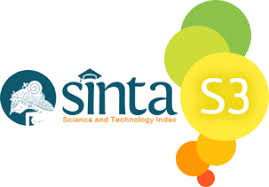Negosiasi dan kerja tripartit dalam penanganan krisis komunikasi perusahaan: tinjauan pada kinerja csr
 Abstract views: 971
,
Abstract views: 971
,
 PDF downloads: 828
PDF downloads: 828
Abstract
An unexpected event that has the potential to cause turmoil and changes in an environment is referred to as a crisis. The emergence of a crisis in the organization can damage the image and reputation of the company. If a crisis arises in a company and is publicized, it can lead to a bad perception of the company, organization or individual. So that it is necessary to have a public relations role to formulate communication program planning procedures in solving crises. However, if a settlement between the worker and the company cannot be resolved, then a mediator is needed or called the Tripartite model. The purpose of this study was to determine the tripartite model in handling corporate communication crises in terms of the performance of Corporate Social Responsibility. The method used in this research is phenomenology, where the informant in this study is the company's public relations officer. The conclusion of this study shows that the involvement of third parties (tripartite model) is not carried out by companies that have done to the environment and the community through introduction to the environment so that they can determine the Corporate Social Responsibility program appropriately and handle crisis communication well.
References
Coombs, W. (2021). Ongoing crisis communication: Planning, managing, and responding. Sage Publications.
Coombs, W., & Holladay, S. (2011). The handbook of crisis communication. John Wiley & Sons. https://doi.org/https://doi.org/10.1002/9781444314885
Creswell, J., & Poth, C. (2017). Qualitative inquiry and research design: Choosing among five approaches. California: Sage publications.
Fearn-Banks, K. (2016). Crisis communications: A casebook approach. Routledge. https://doi.org/https://doi.org/10.4324/9781315684857
Hadi, N. (2011). Corporate Social Responsibility (CSR) Edisi 1. Jakarta: Graha Ilmu.
Hardoko, A., Susilo, & Pardosi, J. (2012). Resolusi konflik melalui disain managemen program sinergi revitalisasi antara pemerintah (Disbun/Distamben) dengan corporate social responsibility (CSR) berbasis kooridor pemberdayaan ekonomi di Kalimantan Timur: laporan akhir penelitian MP3EI. Lembaga Penelitian, Universitas Mulawarman.
Husserl, E. (2014). Ideas: General introduction to pure phenomenology. Routledge. https://doi.org/10.4324/9781315823577
Ismail, R., Karyaningsih, Chin, J., & Prabowo, T. (2022). Why CSR communication also has good and negative consequences on a company’s social responsibility? Jurnal Komunikasi Profesional, 6(1 SE-Articles), 56–67. https://ejournal.unitomo.ac.id/index.php/jkp/article/view/4469
Komunikasipraktis.com. (2021). Pengertian Komunikasi Krisis dan Strateginya. https://www.komunikasipraktis.com/2021/04/pengertian-komunikasi-krisis-dan.html
Mendoza, E. (2020). Is CSR a motivator for socially responsible customers of for-profit social enterprises? Jurnal Studi Komunikasi, 4(3), 524–540. https://doi.org/https://doi.org/10.25139/jsk.v4i3.2593
Miles, M., & Huberman, A. (1994). An expanded sourcebook: Qualitative data analysis (2nd Edition). In Sage Publications. https://doi.org/10.1016/0149-7189(96)88232-2
Muslikah, N. (2020). Model Penyelesaian Tripartit dalam Sengketa Hubungan Industrial di Dinperinaker Purworejo. Amnesti Jurnal Hukum, 2(1), 24–32.
Nugroho, B., Arief, A., Dharta, F., Suryani, K., & Utomo, S. (2022). Model corporate social responsibility dalam penanganan komunikasi krisis selama pandemi covid-19 di Indonesia. Jurnal Komunikasi Profesional, 6(2), 129–138.
PPRI/46/2008. (2008). Perubahan atas peraturan pemerintah nomor 8 tahun 2005 tentang tata kerja dan susunan organisasi lembaga kerja sama tripartit.
Silviani, I. (2020). Public Relations sebagai Solusi Komunikasi Krisis. SCOPINDO MEDIA PUSTAKA.
Suwandi, B. (2008). Memahami Penelitian Kualitatif. Jakarta: PT Reneka Cipta.
Zebua, W., Utari, S., & Djuwardie, D. (2021). Komunikasi Krisis Grab Indonesia pada Kasus Kecelakaan Grabwheels dalam Menjaga Citra Perusahaan. Communicator Sphere, 1(1), 1–8.

Jurnal Komunikasi Profesional is licensed under a Creative Commons Attribution-ShareAlike 4.0 International License.
Â
Â
1. Proposed Policy for Journals That Offer Open Access
Authors who publish with this journal agree to the following terms:
- Authors retain copyright and grant the journal right of first publication with the work simultaneously licensed under a Creative Commons Attribution License that allows others to share the work with an acknowledgment of the work's authorship and initial publication in this journal.
- Authors are able to enter into separate, additional contractual arrangements for the non-exclusive distribution of the journal's published version of the work (e.g., post it to an institutional repository or publish it in a book), with an acknowledgement of its initial publication in this journal.
- Authors are permitted and encouraged to post their work online (e.g., in institutional repositories or on their website) prior to and during the submission process, as it can lead to productive exchanges, as well as earlier and greater citation of published work (See The Effect of Open Access).
2. Proposed Policy for Journals That Offer Delayed Open Access
Authors who publish with this journal agree to the following terms:
- Authors retain copyright and grant the journal right of first publication, with the work [SPECIFY PERIOD OF TIME] after publication simultaneously licensed under a Creative Commons Attribution License that allows others to share the work with an acknowledgement of the work's authorship and initial publication in this journal.
- Authors are able to enter into separate, additional contractual arrangements for the non-exclusive distribution of the journal's published version of the work (e.g., post it to an institutional repository or publish it in a book), with an acknowledgement of its initial publication in this journal.
- Authors are permitted and encouraged to post their work online (e.g., in institutional repositories or on their website) prior to and during the submission process, as it can lead to productive exchanges, as well as earlier and greater citation of published work (See The Effect of Open Access).


